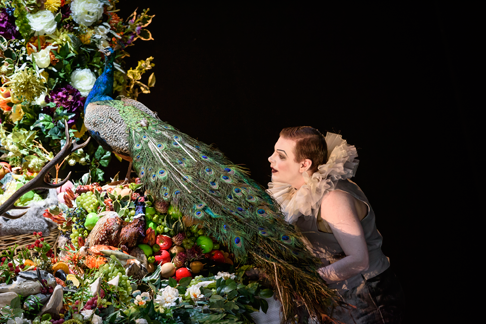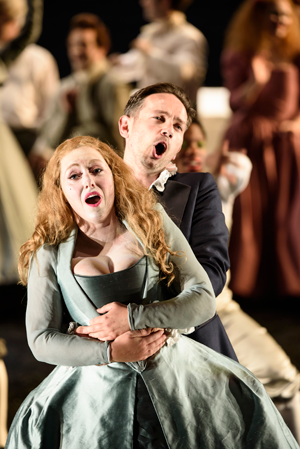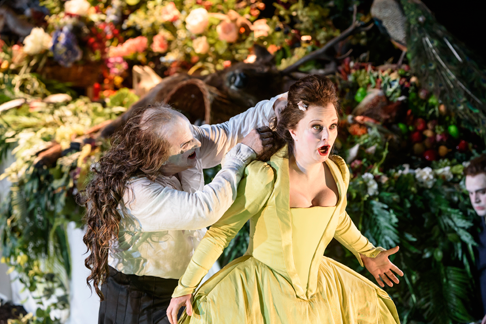Barrie Kosky‘s much anticipated new production of Handel’s Saul
opened at the Glyndebourne Festival on 23 July 2015, Kosky’s debut at the
house and their first production of Saul. Though not an opera and
never intended for the stage, Handel’s oratorio Saul is one of his
most dramatic works and Kosky created from it a remarkable piece of theatre. A
strong cast was led byChristopher
Purves as Saul, andIestyn Davies
as David, withLucy
Crowe as Merab,Sophie
Bevan as Michal,Paul
Appleby as Jonathan, John
Graham-Hall as the Witch of Endor and Benjamin Hulett as Abner, High Priest
and Amalekite.Ivor Bolton directed the
Orchestra of the Age of Enlightenment from
the harpsichord. Designs were by Katrin Lea Tag, with choreography by Otto
Pichler, and lighting by Joachim Klein.
Handel’s oratorio Saul was premiered in London in 1739. It has a
libretto by Charles Jennens, who not only wrote the libretto for
Messiah but was responsible for some of Handel’s most remarkable
dramatic oratorios. The piece was intended as theatre of the mind, though
premiered in the theatre it was performed in concert but Handel’s scores
include stage directions clearly indicating the way his mind worked in these
circumstances. What a piece like Saul gave him was a sense of real
narrative clarity, this was a story everyone knew and which had a clear
development from beginning, middle to end, very different from the convoluted
scene based drama of the opera seria, where it was the effect of
individual scenes which mattered rather than the (sometimes ludicrous)
progression from scene to scene. Handel’s response was a dramatic meditation
on the story, sometimes action proceeds at lightening pace (in the Glyndebourne
programme book Barrie Kosky talks of the way, freed from da capo arias, Handel
sometimes write music of extraordinary concision), but then there will be a
long chorus when the action is frozen and the chorus almost steps out of the
drama to consider it, and talk about it to us.
This gives the director remarkable freedom, there is a lack of specificity
about the dramaturgy which can be filled in many ways. Of course, there are
problems; you have to find something to do during the long choruses with all
those singers on stage, and something which has a dramatic coherence and does
not look like decoration merely added in. In 2012 I saw two very different
stagings of Handel’s Jephtha (Frederic Wake Walker’s at the Buxton
Festival, and Katie Mitchell’s at WNO) which showed quite how responses to
the drama could vary.
 Benjamin Hulett as the High Priest
Benjamin Hulett as the High Priest
If I say that Barrie Kosky had clearly listened to Handel’s music and
created a piece of theatre based on it, then that is intended as a great
compliment as too often I get the impression that directors stage the libretto
rather than the musical drama. Kosky, designer Katrin Lea Tag and choreographer
Otto Pichler created a semi-abstract, coherently thought through response to
the music. Kosky and Ivor Bolton drew some remarkable performances from the
singers and players. One of the themes that Kosky identified in the piece,
which his staging brought out strongly, was the King Lear like
resonances with a King who goes mad, and two warring daughters. Kosky had
increased these resonances by conflating the small roles of Abner, the High
Priest and the Amalekite into a single fool-like role.
I say advisedly that this was a remarkable piece of theatre because though
Handel’s score was at the very core of the piece, Kosky had added two
elements to it which gave the staging some of its specificity (and added the
Marmite element too, you either loved or hated it with little in between).
First the sound, the whole piece had an extra aural sound-track ranging from
the whoops and cries of the chorus, through the communal thumpings, bangings
and shoutings, to the shouted extra dialogue and Saul’s ravings. Some of this
was a response to the drama going on in counter-point to the music, for
instance when Saul presented Merab to David she was furious and Saul and Merab
had an encounter which, not in the score, was performed in dumb-show but with
the odd sound which intruded on the music. Also, there were many moments when
you felt that Kosky did not find Handel’s music quite enough, and needed to
add something. The results added up to an extra aural component which was
present enough for me to find unsatisfactory and disturbing. If you listen to a
radio broadcast of the performance then you are likely to find it slightly
strange at times.
 Sophie Bevan as Michal and Iestyn Davies as David
Sophie Bevan as Michal and Iestyn Davies as David
The second element was visual, dance played a large part in the whole
performance. There were six dancers who made a strong element to the overall
drama. But Otto Pichler’s choreography extended to the singers too so that
whatever you thought of his visual language, he and Kosky had folded movement
into the whole ensemble rather than just adding a couple of dancers for window
dressing. Like everything else in the production, this was the result of
strong, thoughtful decisions which I appreciated. Unfortunately, I did not
respond to Otto Pichler’s visual vocabulary and found the dance element
neither expressive nor stimulating, feeling that his perky, energetic
choreography rather trivialised the music.
The evening opened with a series of visual coups. First the overture was
played with the curtain down, with just a huge bloody head of Goliath visible,
definitely a big plus point. Then as the curtain opened we saw Iestyn Davies as
David, stripped to the waist, bloodied and clearly traumatised, then suddenly
the rear curtain rose to reveal a huge table set for a feast (like the 16th
century Dutch still life printed in the programme book), on which the chorus
was sitting and standing. For the opening sequence the chorus moved, in
stylised way on this table and then the ensemble developed with the dancers
coming on. Costumes were neo-baroque, creating an exotic, slightly a-historical
feel and in the huge wigs and overdone white make-up, creating a sense of
parody too.
The whole piece took place in this space, with it plain walls and the floor
of artificial earth (clearly this season’s must-have for directors, following
on from Covent Garden’s recent production of Rossini’s Guillaume
Tell). The dinner interval was after the Act Two duet for David and Michal
(O fairest of ten thousand fair) and its subsequent chorus.
The second half opened the symphony and formed a clear divide with the
second part as the dark part, opening in darkness with a field of candles and
with the performers now dressed in black.
 Christopher Purves as Saul and Lucy Crowe as Merab
Christopher Purves as Saul and Lucy Crowe as Merab
Though the visual language for the production was strong and pervasive, and
at times I found it to be hyper-active, Kosky was responding to the music and
when demanded gave us simplicity. David’s singing of his aria to sooth Saul,
and then quietly cradling him whilst the harp played, or the Dead March
performed with a stage strewn with bodies but no other accompanying action. And
whatever you thought about the visual language, Kosky drew some truly
remarkable performances from his cast.
Christopher Purves’ account of the title role was truly Lear-like, as he
depicted Saul’s complete descent into madness. The occasional mad episodes in
the first part turning into complete ravings in the second. It was a truly
fearsome and mesmerising performance, and Purves was gripping in his singing of
Handel’s music (Saul hardly gets a proper aria, the role is almost all
recitative and arioso). But the performance came at some cost to the music, as
Purves created the sense of madness by distorting the vocal line (thankfully
only occasionally), and by adding extra spoken contributions to create intense
theatre.
Iestyn Davies as David was slightly cool, calm and unreadable. He started
with David traumatised and shell shocked, and there was a sense in which the
character took most of the piece to recover from the opening drama with
Goliath. This was counter-parted by the cool beauty of Davies’ singing and
his account of O King, whose mercies are numberless was one of the
highlights of the evening. But David’s character is also puzzling because of
the dramaturgy of the piece, as he develops strong relationships with both
Jonathan and with Michal. Kosky’s production gave a clear sexual element to
the relationship with Jonathan (with the two in a steamy clinch at one point),
but offered little in the way of explanation except to suggest that David was
an opportunist schemer. But the beauty and intelligence of Iestyn Davies
performance helped to bring the role alive in multiple ways.
Lucy Crowe made Merab a far more interesting character than can sometimes
happen, and Crowe’s plangent tones, thrilling and beautiful yet extremely
calculated, meant that even when at her most vicious we responded to Merab in a
way. The bleached plangency and technical perfection of Crowe’s performance
of Merab’s music ensured that the contrast with the two sisters was played up
as Sophie Bevan’s Michal was all bubbly, running-around excitement. From the
first moment Bevan set eyes on Davies, it was clear that Michal was obsessed
with David and Bevan really brought this over. She was a complete delight in
the arias, bringing a real sense of charm.
The young American lyric tenor, Paul Appleby was new to me. He brought a
strong sense of interior drama to Jonathan, he too was very taken with Iestyn
Davies’ David from the first moment and their relationship was developed and
played out very clearly. In that sense he made a fine component to the drama,
but Jonathan is perhaps an underwritten role and Appleby did not manage to make
the music really count. He sang effectively, but without the specificity of the
other performers and I have to confess that I found his phrasing a bit lumpy at
times.
Benjamin Hulett was truly brilliant as the new fool-like character, welding
his sequence of almost random arias into a clear role and having an omnipresent
theatrical effect which gave a strong counterpoint to the drama. We never did
work out why he was given artificially large bare feet (we have to assume that
Hulett’s real toes are not that size!), perhaps to give a sense that this is
a Pan-like observer and commentator. His interventions, and arias sung to the
audience brought a real feel of extra commentary to the drama and his music
performance was spot on and certainly showed him ready to take on larger roles.
Thankfully the role of the Witch of Endor was cast with a man, as it should
be, and John Graham-Hall brought a wealth of experience to the role. Kosky
seems to have seen the scene in Lear-like blasted heath terms. By now
Christopher Purves’ Saul was stripped to his boxer shorts and John
Graham-Hall’s witch appeared out of the ground and was an old crone also
stripped to the waist with huge pendulous breasts on which Saul sucked, and the
voice of Samuel spoke through Saul so that Purves sang both roles. It created
an incredible piece of theatre from what is one of the strongest scenes in the
oratorio.
The hard working chorus was amazing, singing Handel’s taxing, large-scale
choruses with both strength and expressiveness. For the more serious ones, such
as the big jealously on, their range of movement was restricted as Kosky
clearly wanted us to concentrate on the music and there was a great deal to
enjoy. For the livelier choruses in Act One we were treated to the sight of
them dancing and singing, and this did on occasion cause some instability in
the ensemble, but overall this was a powerful, strongly sung account of one of
Handel’s finest oratorio choruses. Daniel Shelvey from the chorus took the
small role of Doeg.
The organ solo in the symphony which opened part two was performed by James
McVinne, on-stage and costumed playing a chamber organ on a platform spinning
round in the midst of the field of candles – just one of the visual images
which was inexplicable yet stunning. In the pit the Orchestra of the Age of
Enlightenment, with continuo from Luise Buchberger (cello), Chi-Chi Nwanoku
(bass), Paula Chateauneuf (theorbo), Luke Green (harpsichord) and Bernard
Robertson (organ), were directed from the harpsichord with aplomb by Ivor
Bolton. He drew strong, characterful playing from the orchestra and the work
gave plenty of scope for individuals to shine, but also clearly gloried in the
varied sounds of Handel’s orchestra.
Barrie Kosky has a very distinctive theatrical language and the big virtue
of his production of Handel’s Saul was the way he used it
unashamedly but always expressively. The first night audience at Glyndebourne
reacted extremely positively, and clearly enjoyed some of the elements (such as
the dancing) which I found more disturbing. This was a truly memorable event,
as Kosky and his collaborators and cast had created a strong theatrical event,
really bringing Handel’s theatre of the mind to life on stage.
Robert Hugill
Cast and production information:
Saul:Christopher Purves, David: Iestyn Davies, Merab: Lucy Crowe,
Michal: Sophie Bevan, Jonathan: Paul Appleby, Abner/High Priest/Amalekite
Benjamin Hulett, Doeg: Daniel Shelvey, Witch of Endor: John Graham-Hall.
Director: Barrie Kosky, designer: Katrin Lea Tag, choreographer: Otto Pichler,
lighting: Joachim Klein. Conductor: Ivor Bolton, Orchestra of the Age of
Enlightenment; Glyndebourne Festival Opera, 23 July 2015.
image=http://www.operatoday.com/%C2%A9BC20150718_SAUL_147.png
image_description=Christopher Purves as Saul [Photo by Bill Cooper]
product=yes
product_title=Saul, Glyndebourne
product_by=A review by Robert Hugill
product_id=Above: Christopher Purves as Saul
Photos by Bill Cooper